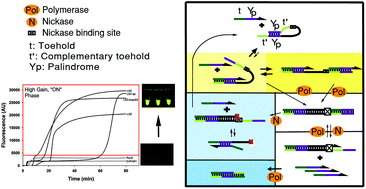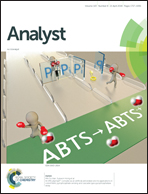First characterization of a biphasic, switch-like DNA amplification†
Abstract
We report the first DNA amplification chemistry with switch-like characteristics: the chemistry is biphasic, with an expected initial phase followed by an unprecedented high gain burst of product oligonucleotide in a second phase. The first and second phases are separated by a temporary plateau, with the second phase producing 10 to 100 times more product than the first. The reaction is initiated when an oligonucleotide binds and opens a palindromic looped DNA template with two binding domains. Upon loop opening, the oligonucleotide trigger is rapidly amplified through cyclic extension and nicking of the bound trigger. Loop opening and DNA association drive the amplification reaction, such that reaction acceleration in the second phase is correlated with DNA association thermodynamics. Without a palindromic sequence, the chemistry resembles the exponential amplification reaction (EXPAR). EXPAR terminates at the initial plateau, revealing a previously unknown phenomenon that causes early reaction cessation in this popular oligonucleotide amplification reaction. Here we present two distinct types of this biphasic reaction chemistry and propose dominant reaction pathways for each type based on thermodynamic arguments. These reactions create an endogenous switch-like output that reacts to approximately 1 pM oligonucleotide trigger. The chemistry is isothermal and can be adapted to respond to a broad range of input target molecules such as proteins, genomic bacterial DNA, viral DNA, and microRNA. This rapid DNA amplification reaction could potentially impact a variety of disciplines such as synthetic biology, biosensors, DNA computing, and clinical diagnostics.

- This article is part of the themed collection: Analyst Recent HOT articles


 Please wait while we load your content...
Please wait while we load your content...